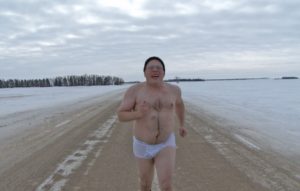- 81 minutes. Not rated.
“So, back in the day, like, hundreds of years ago, when they rode horses with wagons trying to get west before winter… Anyway, sometimes something or other would go wrong and then they wouldn’t make it far enough west before winter hit, and the they’d be stuck out in the cold, you know, out in the prairie with nothing. You can about imagine what that would be like.”

Prairie Love is the anti-chick flick. It’s sort of a love story, but mostly a tale of desperation and romantic failure that’s so sad it’s funny. The main character is a drifter (Jeremy Clark) who cares much more about the deer carcass he’s trying to sell and the relationship he plans to have (someday) than he does about people. Nevertheless, he saves the life of the NoDak, who he finds frozen on the prairie (Garth Blomberg). The NoDak is on his way to meet a female convict (Holly Lynn Ellis) with whom he has corresponded for three years. When the drifter figures out that the two pen pals intend to begin a romantic relationship as soon as possible, and that they’ve never laid eyes on one another, he gets rid of the NoDak and takes his place at the convict’s release, gaining both a girlfriend and a mess of unexpected complications.
Awkward hilarity ensues. The drifter’s repeated attempts to get into the convict’s pants are pinned entirely on passages from her letters that he memorizes and repeats back to her. Unable to deter him, the convict finally agrees to shower together – but wears her underwear. This painful humor suffuses the otherwise simply painful story and makes the circumstances palatable. There is certainly no way that the drifter would be likable if it were not for his incongruous self-help tapes and childish antics with the cowboy duds.
Prairie Love brings atmosphere to a whole new level. Aside from NoDak, the drifter, the convict, and an incidental policeman and prison guard, there are no humans in this movie. These people aren’t just isolated – they’re trapped in the ninth level of Hell as re-designed by Jean-Paul Sartre. The climate is more than just another character–it is a prerequisite for the existence of the plot and the characters. I enjoyed the many beautiful shots of lonely figures struggling through grim, silent snowscapes, slowly freezing to death.
At 81 minutes, Prairie Love is a long short film, with the difference made up for in character development. Though this makes for a slow movie, especially in the period before the drifter meets the convict, I was engaged enough that I didn’t mind the pace. This is something I also experience while watching many Coen Brothers movies (As readers may already be aware, I am an ardent fan of the Coen Brothers).
From the broken truck to the constant disappearance of the deer carcass to the shocking discharge of the stolen handgun, everything the drifter touches rebels against him. It is unclear whether things fail to happen because he is repulsive, or if he is repulsive because things have failed to happen. His constant abortive efforts to escape the loop frustrate and exhaust him, partly because he expects his honest endeavors to fail.
Oddly, the convict herself seems quite innocent. It stretches credibility that a criminal, even such a young one, would not be suspicious of the thoroughly strange drifter. But the flaw that causes her to go with the drifter is eventually demonstrated to be believably complicated. She also has an overwhelming pattern: restriction. It is the convict who hacks the dead deer’s leg off, (to prevent it from running away,) who wants to be zipped into a tight-fitting dress, and who captures her feelings in print. Though the drifter attempts to take control of their relationship, it is ultimately the convict who designates the boundaries.
Their extremes basically generate their tragic situation. The convict can’t fathom that her plans won’t work, and the drifter can’t fathom that his plans will. They meet in the middle.
The NoDak’s only function within the film is to set up the relationship. Like the convict, he has a plan; like the drifter, things just never work out for him. He is the human representation of the middle at which the drifter and the convict meet, an idealistic being incapable of surviving in its own uncompromising environment.
I was blown away by the creative synergy between the director (Dusty Bias) and the actors. Not only are the performances superb, but the actors’ strongest points are artfully accentuated in every way. Considering that there were only three people in the film, this was the critical key.
Prairie Love was over too soon. I liked it. This was a legitimately good movie. Don’t show it to a date – watch it with your significant other. Then think about how lucky you are to live in the Northeast.
